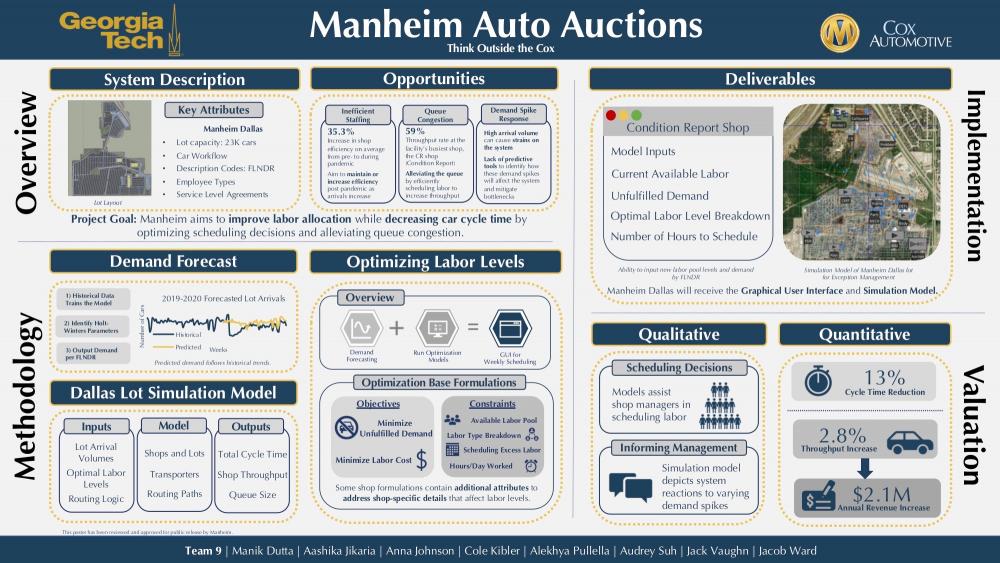Client Context
Our client, Manheim, Inc., is a wholesale auto-auction industry leader in buying and selling used vehicles through auto-auctions. Specifically, the Manheim Dallas facility, which has a lot capacity of 23,000 vehicles, increased labor efficiency during the COVID-19 pandemic.
Project Objective
The increased labor efficiency during the pandemic introduced an opportunity for Manheim Dallas to operate with a more efficient allocation of labor. We have identified three areas of improvement: inefficient staffing, queue congestion, and demand spike response. The operations team at Dallas would like to adjust labor allocation to increase labor efficiency as the COVID-19 pandemic ends and car arrival volume increases. Additionally, certain shops at Manheim experience more queue congestion than others and this creates bottlenecks in the total lot system. Eliminating bottlenecks will allow for throughput rate increase. Finally, Manheim Dallas lacks predictive tools that would allow the Operations team to see how demand spikes affect the overall system. With our deliverables, Manheim Dallas will be able to decrease overall vehicle cycle times, and improve their labor allocation.
Design Strategy
Our initial approach for this project was to collect and analyze data given by the client to determine the opportunities, which were queue congestion, a lacking demand spike response, and inefficient staffing. From there we decided to create an optimization model for the inefficient staffing and a simulation model to handle varying demand arrivals; both of these consequently can address queue congestion. To develop these models, we created a demand forecasting model based on historical data that would predict incoming arrival volume to the lot by car type. After this, we simultaneously worked on the optimization and simulation models. While developing both models, we kept in contact with our client to ensure that our models were as true to the system as possible and to clarify any doubts or questions that arose. Once the models were completed, we fed the incoming arrival volumes, generated by the demand forecasting model, into both the simulation and optimization models to receive the outputs. For the optimization model, we focused on staffing levels and made sure that our generated numbers were similar to the labor levels from previous data. For the simulation model, we focused on throughput levels and ensured that our numbers were similar to those from historical data as well. Once both of our models were validated separately according to previous data, we took the labor levels generated by the optimization models for those weeks and inputted them into the simulation model to receive the new, forecasted throughput; our throughput levels were greater than those from historical data from the same weeks, indicating that our models were functioning properly.
Deliverables
We designed, developed, and validated a Staff Scheduling Optimization Tool and a Dynamic System Simulation Model. The optimization tool minimizes unfulfilled demand and labor cost, providing Manheim Dallas with the optimal labor levels per shop, which will depend on forecasted arrival data. The optimal labor levels will allow Manheim to utilize their labor force more efficiently, thus helping Manheim to reduce idle time and backlog hours in the system. We then packaged the Optimization Tool into a Graphical User Interface for further accessibility to the models for the client. The Graphical User Interface will assist managers in making more informed staffing decisions in response to the varying arrivals to the system. The simulation model (1) reflects the current system, (2) quantifies the effects of changes to the system based on the results from the optimization tool, and (3) models the changes on the system when subject to exceptional demand volumes. The simulation tool will allow for more visibility of the system. Manheim Dallas will use these deliverables as decision-making tools, especially in situations that require exception management.
The biggest insights our deliverables offer Manheim are the ability to simulate the systems response to demand changes in the future and to assist managers in making scheduling decisions based on incoming demand. The recommendation for Manheim would be to implement the simulation model for operations improvement and to use the labor optimization tool when making staffing decisions. We also recommend that Manheim employees familiarize themselves with our deliverables for a smoother transition into utilizing these tools during their workday.


